A step by step guide for Brinjal Farming in India:
The following information is about the farming of brinjal vegetable, brinjal planting from seeds and eggplant cultivation practices.
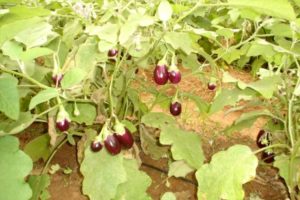
Introduction of Brinjal (Eggplant):
Brinjal or Eggplant is an important crop of subtropics and tropics. The name brinjal is popular in Indian subcontinents and is derived from Arabic and Sanskrit whereas the name eggplant has been derived from the shape of the fruit of some varieties, which are white and resemble in shape to chicken eggs. It is also called aubergine (French word) in Europe. The brinjal is of much importance in the warm areas of the Far East, being grown extensively in India, Bangladesh, Pakistan, China, and the Philippines. It is also popular in Egypt, France, Italy, and the United States. In India, it is one of the most common, popular and principal vegetable crops grown throughout the country except higher altitudes. It is a versatile crop adapted to different agro-climatic regions and can be grown throughout the year. It is a perennial but grown commercially as an annual crop. A number of cultivars are grown in India, consumer preference being dependent upon fruit color, size, and shape.
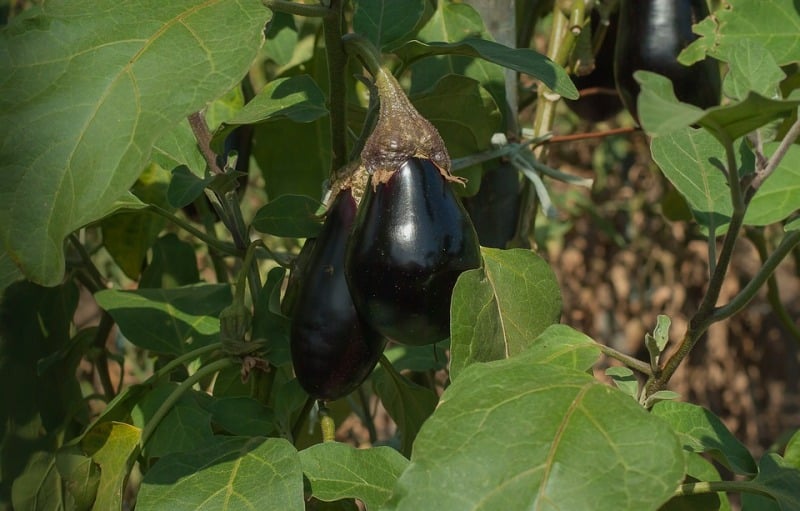
Brinjal Varieties in India:
Below are the main brinjal hybrid varieties cultivated in India.
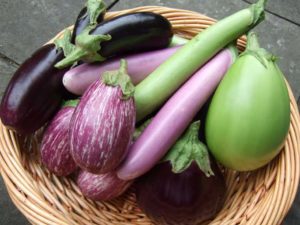
Pusa Purple Long :
It is an early maturing and long fruited type variety. Fruits are glossy, light purple in color, 25-30 cm long, smooth and tender. The crop is ready for picking in 100 to 110 days. Suitable for spring and autumn plantings, the average yield is 27.5 t/ha. It is moderately tolerant to shoot borer and little leaf disease.
Pusa Purple Cluster:
It is an early maturing and long fruited type variety. Fruits are small, dark purple in color and borne in clusters. The crop is ready for picking in 75 days after transplanting. Variety is resistant to little leaf disease under natural conditions.
Pusa Kranti:
This variety has a dwarf and spreading growth habit. Fruits are oblong and stocky than slender with attractive dark purple color. Good for both spring and autumn plantings under North Indian conditions. The crop matures in 130-150 days. Average yield is 14-16 t/ha.
Pusa Barsati:
This variety has a dwarf and erect growth habit devoid of thorns. Fruits are medium, long and purple with an average yield of 35.5 t/ha.
Manjri Gota:
This variety has a dwarf and spreading growth habit. The fruits are medium-large, round and purple colored with white stripes. Upon maturity, the fruits attain a golden yellow color. Average yield is 15- 20 t/ha.
Vaishali:
The variety has a dwarf and spreading type of growth habit. Fruits are oval in shape purple in color with white stripes. The stalks of the fruits bear spines. The crop is ready for first picking within 60 days after transplanting. Average yield is 30 t/ha.
Arka Navneet:
This brinjal variety is high yielding hybrid. Fruits are large oval to oblong with deep purple shining skin with each fruit 450 g in weight. Purple flowers with the solitary bearing habit. Free from bitter principles with very good cooking qualities. The crop is ready for picking in 150-160 days. Average yield is 65-70 t/ha.
Arka Sheel:
This type of brinjal is medium long with deep shining purple skin. Calyx is fleshy and green. Purple flower with the solitary bearing habit. The crop is ready for picking in 150-160 days. Average yield is 38 t/ha.
Arka Kusmukar:
This brinjal type has spreading plant habit with green stem & green leaves. Flowers white green small fruits are borne in the cluster. Soft texture with good cooking quality. The crop is ready for picking in 140-150 days. Average yield is 40 t/ha.
Arka Nidhi ( BWR – 12):
This is high yielding brinjal variety with resistance to bacterial wilt. Fruits are borne in the cluster. Calyx purplish green. Fruits free from bitter principles with slow seed maturity and good cooking quality. The crop is ready for picking in 150 days. Average yield is 48 t/ha.
Arka Keshav ( BWR – 21 ):
This is a high yielding bacterial wilt resistant variety. Fruits tender, free from bitter principles with seed maturity. The crop is ready for picking in 150 days. Average yield is 45 t/ha.
Arka Neelkanth ( BWR – 54 ):
This is a high yielding brinjal variety with bacterial wilt resistance. Fruits tender, free from bitter principles with seed maturity. The crop is ready for picking in 150 days. Average yield is 43 t/ha.
Pusa Ankur:
These types of brinjal are oval-round, small-sized (60-80g), dark purple, attractive fruits. Fruits are small, oval-round, bark purple, glossy and very attractive, weighing each 60-80g. It is an early bearing and becomes ready for first picking 45 days after transplanting. Its fruits do not lose color and tenderness even on delayed pickings.
You may be interested in Smart Farming in India.
The climatic requirement for Brinjal production:
The brinjal is a warm season crop, therefore susceptible to severe frost. Low temperature during the cool season causes deformation of vegetables. A long and warm growing season is desirable for successful brinjal farming. Cool nights and short summers are not suitable for satisfactory production. A daily average temperature of 13 to 21°C is most favorable for optimum growth and yield. The brinjal seed germinates well @ 25°C
Soil requirement of Brinjal plantation:
The brinjal plants can be grown in all types of soil varying from light sandy to heavy clay. Well-drained soil is rich in organic matter with a pH of 6.5-7.5. Light soils are good for an early yield, while clay-loam and silt-loam are well suited for higher yield.
Soil Preparation for Brinjal plantation:
Since the crop remains in the field for a number of months. The soil should be thoroughly prepared by plowing 4 to 5 times before transplanting the seedlings. Bulky organic manures like well rotten crowding or compost should be incorporated evenly on the soil. Thoroughly prepare the field with the addition of FYM @ 25 tonnes/ha and form ridges and furrows at a spacing of 60 cm. Apply 2 kg/ha of Azospirillum and 2 kg/ha of Phosphobacteria by mixing with 50 kg of FYM. Irrigate the furrows and transplant 30-35 days old seedlings at 60 cm apart on the ridges.
Season of Sowing for Brinjal seeds:
December – January, and May – June.
Nursery bed preparation for Brinjal seedlings:
Apply FYM 10 kg, neem cake 1 kg, VAM 50 g, enriched superphosphate 100 g and furadon 10 g per square meter before sowing. Area required for raising seedling for planting 1.0 ha is 100 sq.m.
A seed rate of Brinjal:
Varieties : 400 grams /ha, Hybrids : 200 grams/ha.
Brinjal seed treatment procedure:
Treat the brinjal seeds with Trichoderma viride @ 4 g / kg or Pseudomonas fluorescens @ 10 g / kg of seed. Treat the seeds with Azospirillum @ 40 g / 400 g of seeds using rice gruel as adhesive. Irrigate with a rose can. In raised nursery beds, sow the seeds in lines at 10 cm apart and cover with sand. Transplant the seedlings 30 – 35 days after sowing at 60 cm apart in the ridges.
Transplanting in Brinjal Farming:
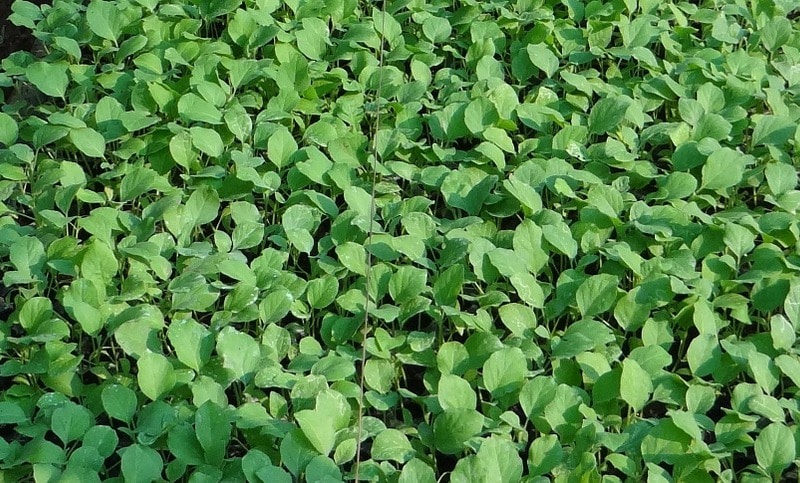
The seedlings are ready in 4-5 weeks for transplanting, when they attained a height of 12-15 cm with 3-to 4leavess. Harden the seedlings by withholding irrigation. Uproot the seedlings carefully without injury to the roots. Transplanting should be done during evening hours followed by irrigation. Firmly press the soil around the seedlings. Spacing depends upon the fertility status of soil, type of verities and suitability of the season. In general 60×60 cm spacing is kept for non-spreading type verities and 75-90×60-75 cm for spreading type verities
You may also check the How to Make an Organic Compost from Manures, Wastes.
Water requirement of Brinjal plants:
Water the field as per the need of the crop. Timely irrigation is quite essential for good growth, flowering, fruit setting and development of fruits. Higher yield may be obtained at optimum moisture level and soil fertility conditions. In plains, irrigation should be applied every third to the fourth day during hot weather and every 7 to12 days during winter. Irrigation is given before top dressing of there is no rain. The brinjal field should be regularly irrigated to keep the soil moist during frosty days.
Layout and planting for drip irrigation and fertigation of Brinjal:
- Apply FYM @ 25 t / ha as basal dose before the last plowing.
- Apply 2 kg/ha of Azospirillum and 2 kg/ha Phosphobacteria by mixing with 50 kg of FYM.
- Apply 75 % total recommended dose of superphosphate i.e. 703 kg/ha as basal.
- Install the drip irrigation with main and sub-main pipes and place lateral tubes at an interval of 1.5 m.
- Place the drippers in lateral tubes at an interval of 60 cm and 50 cm spacing with 4 LPH and 3.5 LPH capacities respectively.
- Form raised beds of 120 cm width at an interval of 30 cm and place the laterals at the center of each bed.
- Before planting, wet the beds using a drip system for 8-12 hrs.
- Planting to be done at a spacing of 90 x 60 x 75 cm in the paired row system, using ropes marked at 75 cm spacing.
- Spray Pendimethalin 1.0 kg a.i./ha or Fluchloralin 1.0 kg a.i/ha as pre-emergence herbicide at 3rd day after planting.
- Gap filling to be done at 7th day after transplanting.
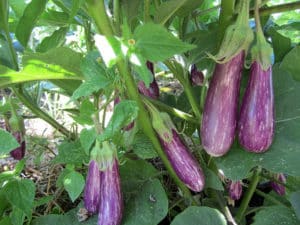
You may also check the Cost, Profit of 1 Acre Brinjal Cultivation.
Intercultural operations and weed control of Brinjal crop:
The weeds should be controlled as soon as they have seen, either by the traditional method of hand weeding and hoeing or by application of herbici8des. Regular or frequent shallow cultivation should be done at regular intervals so as to keep the field free from weeds and to facilitate soil aeration and proper root development. The most serious weed in brinjal is the Orabanchae sp. It is root parasite and it should be controlled carefully. Gap filling should be done wherever needed during evening hours followed by irrigation. Pre-plant soil incorporation of Fluchloralin (1- 1.5 kg/ha) or Oxadiazon (0.5 kg/ha) and pre-planting surface spraying of Alachlor (1-1.5 kg/ha) control the weeds of brinjal successfully.
Manuring application for Brinjal crop
Apply 2 kg each of Azospirillum and Phosphobacteria in the main field at planting.
- Varieties: Basal dose : FYM 25 t/ha, NPK 50:50:30 kg/ ha. Topdressing: 50 kg N/ha on the 30th day of planting or during earthing up.
- Hybrids: Basal dose : FYM 25 t/ha, NPK 100:150:100 kg/ha. Topdressing: 100 kg N/ha on the 30th day of planting or during earthing up.
Fertigation schedule for hybrids of Brinjals:
| Age | Crop stage | Duration in days | Fertilizer grade | Total Fertilizer (kg/ha) | Nutrient applied | % of requirement | ||||
| N | P | K | N | P | K | |||||
| 1 | Transplanting to plant establishment stage |
10 | 19:19:19 +MN 13:0:45 Urea |
39.47 5.50 25.65 |
7.50 0.70 11.80 |
7.50 – – |
7.50 2.50 – |
10.00 | 5.00 | 10.00 |
| Subtotal | 20.00 | 7.50 | 10.00 | |||||||
| 2 | Vegetative stage |
30 | 12:61:0 13:0:45 Urea |
24.50 88.89 142.4 |
2.94 11.56 65.50 |
15.00 – – |
40.00 – – |
40.00 | 10.00 | 40.00 |
| Subtotal | 80.00 | 15.00 | 40.00 | |||||||
| 3 | Flower initiation to first picking |
30 | 19:19:19 +MN 13.0:45 Urea |
39.47 50.00 100.00 |
7.50 6.50 46.00 |
7.50 – – |
7.50 22.50 – |
30.00 | 5.00 | 30.00 |
| Subtotal | 60.00 | 7.50 | 30.00 | |||||||
| 4 | Harvesting | 80 | 12:61:0 13:0:45 Urea |
12.30 44.40 71.13 |
1.48 5.80 32.72 |
7.50 – – |
– 20.00 – |
20.00 | 5.00 | 20.00 |
| Subtotal | 40.00 | 7.50 | 20.00 | |||||||
| 200.00 | 37.50 | 100.0 0 |
100 | 25 | 100 | |||||
Recommended dose: 200:150: 100 kg/ha. 75% of RD of Phosphorus applied as superphosphate = 703 kg/ha.
1. 19:19:19 = 79 kg/ha.
2. 13:0:45 = 189 kg ha.
3. 12:61:0 = 37 kg/ha.
4. Urea = 340 kg/ha.
Pests and Diseases of Brinjal plants:
Shoot and fruit borer
- Remove the affected terminal shoot showing boreholes.
- Remove the affected fruits and destroy.
- Avoid using synthetic pyrethroids.
- Spray Neem Seed Kernel Extract 5% or any one of the following chemicals starting from one month after planting at 15 days interval.
| Insecticide | Dose |
| Azadirachtin 1.0% EC (10000 ppm) | 3.0 ml/lit. |
| Azadirachtin 0.03 % WSP (300 ppm) | 5.0 g/lit. |
| Chlorpyrifos 20 % EC | 1.0 ml/lit. |
| Dimethoate 30 % EC | 7.0 ml/10 lit. |
| Emamectin benzoate 5 % SG | 4 g/10 lit. |
| Flubendiamide 20 WDG | 7.5 g/10 lit. |
| Phosalone 35 % EC | 1.5 ml/lit. |
| Quinalphos 20 % AF | 1.7ml/ lit. |
| Quinalphos 25 % EC | 1.5 ml/lit. |
| Thiodicarb 75 % WP | 2.0 g/lit. |
| Thiometon 25 % EC | 1.0 ml/lit. |
| Trichlorofon 50 % EC | 1.0 ml/lit. |
| Triazophos 40 % EC | 2.5 ml/lit. |
Damping off: Treat the seeds with Trichoderma viride 4 g/kg or Pseudomonas fluorescens 10 g /kg of seed 24 hours before sowing. Apply Pseudomonas fluorescens as soil application @ 2.5 kg/ha mixed with 50 kg of FYM. Water stagnation should be avoided. Drench with Copper oxychloride at 2.5 g/lit at 4 lit/sq.m
Leaf Spot: Leaf spot can be controlled by spraying Mancozeb 2 g/lit in brinjal farming.
Little Leaf: Remove the affected plants in the early stages and spray Methyl demeton 30 EC @ 1.0 ml/lit. to control the vector.
Harvesting and the yield of Brinjal:
The brinjal fruits are harvested when they attain full size and color but before the start of ripening. Tenderness bright color and glossy appearance of the fruit is the optimum stage of harvesting of fruits. When the vegetables look dull, it is an indication of maturity and loss of quality in brinjal farming.
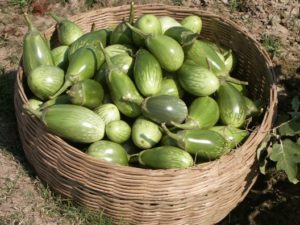
The yield varies from season to season, variety to variety and location to location. However, in general, 250 to 500 quintals/ha of healthy vegetables of brinjal can be obtained from your brinjal farming.
That’s all folks about farming brinjal or growing eggplants on a commercial scale.
You may be interested in Growing Garden Sorrel at Home.
ನಿಮ್ಮ ಈ ಮಾಹಿತಿಯು ಪ್ರತಿಯೊಬ್ಬ ರೈತರಿಗೂ ಉಪಯೋಗವಾಗುತ್ತದೆ. ಧನ್ಯವಾದಗಳು ಸರ್